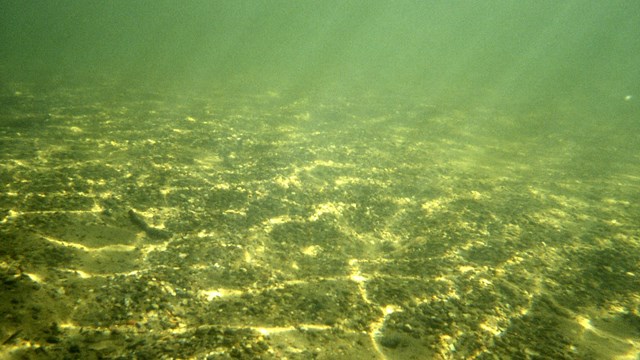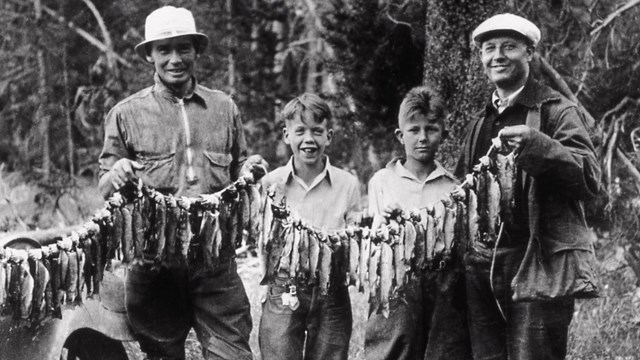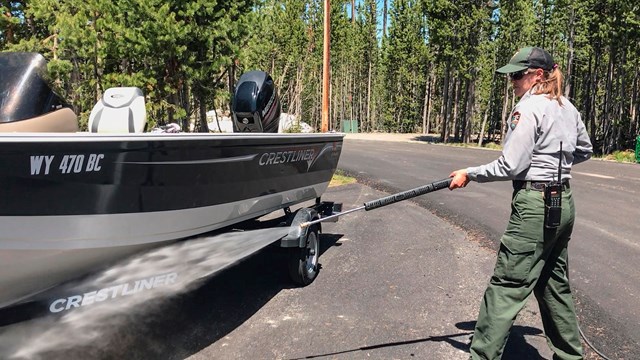
NPS/Neal Herbert Situated at 7,733 feet (2,357 m) above sea level, Yellowstone Lake is the largest high elevation lake (above 7,000 feet / 2,134 m) in North America. It is roughly 20 miles (32.2 km) long and 14 miles (22.5 km) wide, with 141 miles (227 km) of shoreline and a surface area of 132 square miles (342 km2). Yellowstone Lake freezes over completely every winter in late December or early January, with ice thicknesses varying from a few inches to more than two feet. The lake usually thaws in late May or early June. Yellowstone Lake remains cold year-round, with an average water temperature of 41°F (5°C). Because of the extremely cold water, swimming is not recommended. Survival time is estimated to be only 20 to 30 minutes in water at this temperature. Yellowstone Lake has the largest population of wild cutthroat trout in North America. How a Pacific Ocean fish was trapped in a lake that drains to the Atlantic puzzled experts for years. Scientists now believe that Yellowstone Lake once drained to the Pacific Ocean via Outlet Canyon and the Snake River, and that fish swam across the Continental Divide at Two Ocean Pass. Lake trout, an illegally introduced, exotic species, is now found in Yellowstone Lake and threatens the existence of the native cutthroat trout. GeologyRecent research by Dr. Val Klump of the Center for Great Lakes Research and the University of Wisconsin has revolutionized the way we look at Yellowstone Lake. Figuratively, if one could pour all the water out of Yellowstone Lake, what would be found on the bottom is similar to what is found on land in Yellowstone: geysers, hot springs, and deep canyons. With a small submersible robot, the researchers found a canyon just east of Stevenson Island that was 390 feet (119 m) deep. Prior to this finding, the deepest spot in the lake was thought to be 320 feet (97.5 m) at West Thumb. Underwater geysers, hot springs, and fumaroles were found at West Thumb and Mary and Sedge Bays. The hottest spot in the lake was found at Mary Bay where the temperature was recorded at 252°F (122°C). Hollow pipes, or chimneys of silica, several feet in height, were found rising up from the lake bottom at Mary Bay. It is thought that these are the old plumbing systems of now dormant geysers. Rock spires up to 20-feet (6.1-m) tall were found underwater near Bridge Bay. Samples of this rock are being analyzed, though it is believed that these features are probably related to underwater thermal activity. This group of researchers also found that the conditions in Yellowstone Lake are similar to those that occur near the famous hydrothermal vents on the Pacific Ocean's mid-ocean ridge. Nutrient- and mineral-rich submarine fountains support incredible plant and animal communities, including bacterial mats, sponges, and earthworms. In the last decade, geological research has determined that the two volcanic vents, now known as "resurgent domes", are rising again. From year to year, they either rise or fall, with an average net uplift of about one inch per year. During the period between 1923 and 1985, the Sour Creek Dome was rising. In the years since 1986, it has either declined or remained the same. The resurgence of the Sour Creek dome, just north of Fishing Bridge is causing Yellowstone Lake to "tilt" southward. Larger sandy beaches can now be found on the north shore of the lake, and flooded areas can be found in the southern arms. 
Yellowstone Lake Geology
Discover a bit of what dynamic processes are going on below the lake's surface. 
Yellowstone Lake
The earliest intact archeological deposits in the park have been found at a site on the shore of Yellowstone Lake. 
History of Fisheries Management
Fishing has a long history in Yellowstone. The Lake Fish Hatchery produced trout that were used to stock waters in the park and elsewhere. HistoryWilliam Clark's map of 1806-1811 showed what was probably Yellowstone Lake as "Eustis Lake," the name of the Secretary of War under President Jefferson. An 1814 map maker changed Clark's "Lake Biddle" (probably Jackson Lake) to "Lake Riddle," and it may at times also have referred to Yellowstone Lake. The name "Bridger Lake" (now applied to a small lake southeast of the park) may also have applied at times to Yellowstone Lake. In 1826, a party of fur trappers that included Daniel Potts, Bill Sublette, and Jedidiah Smith called Yellowstone Lake "Sublette Lake," and some historians credit Sublette with discovering the lake. Daniel Potts, one of the chroniclers of that 1826 trip, wrote to his family on July 8, 1827, and said that near the headwaters of the Yellowstone River is "a large fresh water lake...on the very top of the mountain which is about one hundred by forty miles in diameter and as clear as crystal" (letter, Yellowstone Park Research Library). Trapper Warren Ferris knew the name "Yellow Stone Lake" by 1831, and he showed it on his map of 1836. By the 1860s, Yellowstone Lake was well-known among former fur trappers, army personnel, and other frequent western explorers. The 1871 Hayden Survey was the first to sail a boat, the Anna, on the waters of Yellowstone Lake, although some fur trappers or Indians may have floated rafts on the lake much earlier. Other early boats used to explore the lake were the Topping in 1874 (see Topping Point), a raft containing government surveyors in 1874, the Explorer in 1880 (see Explorer's Creek), a USGS boat destroyed by lightning in 1885, the Zillah in 1889, and the E.C. Waters (test runs only) in 1905. A boat piloted by Billy Hofer and William D. Pickett made at least one trip on the lake in 1880. 
Boating
Take in the view from the water. 
Clean, Drain, and Dry
Protect park waters by preventing the spread of aquatic invasive species. 
Water
Learn about the role of water in Yellowstone and beyond. |
Last updated: April 18, 2025
